#British nuclear tests at Maralinga
Text
a book about nuclear testing in Australia: to suggest that the tests were unsafe requires there to have been “a gigantic secret conspiracy” (Lorna Arnold, 1987)
yeah ok, I generally try to avoid conspiratorial thinking
another (more recent) book: “22,000 corpses … were pilfered for bones and tested for Strontium-90” (Frank Walker, 2014)
… huh
#mine#australian history#fucking wild dude!!#the British gov was stealing infants bones for actual years without the knowledge of the grieving parents#what the fuck??#what the fuck!?!?!?#maralinga nuclear tests
0 notes
Text
SET FOURTEEN FINAL - ROUND FOUR

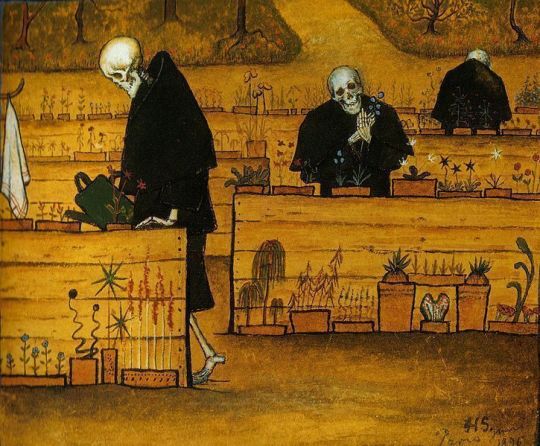
"Thunder Raining Poison" (2015 - Yhonnie Scarce) / "Kuoleman puutarha (The Garden of Death)" (1896 - Hugo Simberg)
THUNDER RAINING POISON: This piece of art is a response to the nuclear testing done by the British Government at Maralinga. The testing transformed the topsoil into green glass, and killed vegetation and animals.
when I see it i want to cry, for me rain always symbolised life, as clichee as it is, i feel good when i walk in the rain, i know how important it is for nature and agriculture to see it twisted like this, with this careless cruelty, that of course as it is specifically hurt Aboriginal people.
The shape and the material are part of the artists Aboriginal heritage, when the whole world is against you for being you just living just continuing being what you are is an act of resistance and strength. And the way this sculpture/installation fills the room despite maybe my stupid biases about the material, the way glass is a material that interacts so much with the environment with how light moves the appearance of it - for me that resonates with the idea of memorial and with that resistance. Writing this tiny little comment my stomach is in twists and I feel like crying. Please look at the art and remember. (anonymous)
KUOLEMAN PUUTARHA (THE GARDEN OF DEATH): Death, but make it involve creation and life. Death, but make it golden and friendly. Memento mori, and that's okay, that's just another part of it all. (ryttu3k)
("Thunder Raining Poison" is an art installation by Yhonnie Scarce made of glass. It was exhibited from 8 October 2015 - 17 January 2016 at the Art Gallery of South Australia.
"Kuoleman puutarha (The Garden of Death)" is a watercolour and gouache painting by Finnish painter Hugo Simberg. It only measures 16 cm × 17 cm (6.3 in × 6.7 in), and is held by the Ateneum. A second version was painted as a fresco in Tampere Cathedral.)
46 notes
·
View notes
Note
Hi I don't have a question but let you know I reblogged your post on Oppenheimer and the non-mention of the victims from the Tularosa village and the Mescalero Apache Reservation involving Native Americans and Hispanic Americans, anyway I haven't seen the film but believe the research done for creating this post and I have added more tags taken from the body of the post. Victims should be acknowledged. I will be posting a similar post about the British atomic tests and how our government in 1955 in north west South Australia requisitioned 1,158 square miles of land for them and as early as 1952 were relocating Anangu people (First Nations or Aboriginal people) from Maralinga Tjarutja lands and then tested 7 atomic bombs and did other tests but didn't adequately warn and find all people before testing causing blindness, radiation poisoning and left with a legacy of radiation related health problems. British packed up and left in 1963 and have since spent along with Australian government cleaning the affected area which some say isn't really complete and handed land back to traditional owners in 2009 and tourists have been coming to Maralinga since 2016 but only being told the British side of the story not the Aboriginal side which I hope has changed now and that the traditional owners who indicated in this research I did wanted to take over the tours of the test site and tell both sides and all the history. Sorry for taking up so much space on your blog but I just needed you to know about the kindred spirit I feel due to the fact my white people in the past did this same thing and many other bad things since invading their country in 1788. We even stole their children away from them. My information came from abc.net.au. Looking at your posts I see you help people find stories in the fandom literature area and I think that is great. I also like that you understand that factual tags are important to find similar subjects in the Tumblr search engine. Cheers from Australia.
Hi there, thank you for this deeply important note! I really appreciate this kinda thing!!!
Glad you mentioned it because I had to mute notifications on my original post — it went up to 10K notes in less than two days and my notifications tab was exploding, so sadly if people are adding interesting things I am missing them.
This is such an important issue and we need to seize the moment to get the word out about the impact of nuclear bomb testing.
I am ashamed to say I didn’t know about the UK tests in Australia and what a surprise, of course it affected Aboriginal Australians. Please tag me in your post so I can read / reblog! I’m very interested in learning further.
❤️
5 notes
·
View notes
Link
I’ve heard about this strange incident a few times. The fact that many of the people living in the area of Maralinga, Australia had never had any contact with Western Civilization before having a literal atomic bomb dropped on them is pretty wild. One factoid I’ve never been able to corroborate: supposedly, there’s already a tribal dance meant to communicate the story for future generations.
#lynette wallworth#australia#indigenous#aboriginal#storytelling#virtual reality#film#nuclear bomb#atomic bomb#nuclear testing
1 note
·
View note
Text
Meet the man who uncovered the scandal of nuclear testing in South Australia
https://aeon.co/videos/meet-the-man-who-uncovered-the-scandal-of-nuclear-testing-in-south-australia
In the 1950s and ’60s, the British government conducted nuclear tests in Maralinga, a remote region of South Australia, with little understanding or forethought of the public health problems the fallout might cause. The harmful, sometimes deadly impact of these tests not only affected military…

View On WordPress
0 notes
Text
Wikipedia article of the day for September 26, 2021

The Wikipedia article of the day for September 26, 2021 is British nuclear tests at Maralinga.
British nuclear tests were conducted at Maralinga in the Woomera Prohibited Area in South Australia between 1956 and 1963. A total of seven major nuclear tests took place at Maralinga, with explosive yields ranging from approximately 1 to 27 kilotonnes of TNT (4 to 110 terajoules). Two major test series were conducted: Operation Buffalo (final test pictured) in 1956 and Operation Antler the following year. One bomb used cobalt pellets as a tracer for determining yield, resulting in rumours that Britain was developing a cobalt bomb. The site was also used for trials of neutron initiators and tests on the compression of nuclear weapon cores and the effects of fire on atomic weapons. It was left contaminated with radioactive waste, and a clean-up was attempted in 1967. A further clean-up was completed in 2000. In 1994, the Australian government paid $13.5 million in compensation to the traditional owners, the Maralinga Tjarutja people. The land was restored to them in 2014.
0 notes
Text
Big shout out to Adz for explaining the Principal Anti Air Missile System.
“This was my first time on board a warship and I was very impressed. I was told about the weapons having their own brains and how they can work out which targets are best to attack at a certain time.”

#remember what the poms did in Maralinga??? no; of course you fucking don't#John Pilger is the only journo who matters--- who cares.#me: ha adz looks hilarious in fatigues vs also me: fuck the british#How about you test your fucking nuclear weapons in your own fucking country
3 notes
·
View notes
Text
SET FOURTEEN - ROUND THREE - MATCH ONE


"Thunder Raining Poison" (2015 - Yhonnie Scarce) / Sagrada Família stained-glass windows (?)
THUNDER RAINING POISON: This piece of art is a response to the nuclear testing done by the British Government at Maralinga. The testing transformed the topsoil into green glass, and killed vegetation and animals.
when I see it i want to cry, for me rain always symbolised life, as clichee as it is, i feel good when i walk in the rain, i know how important it is for nature and agriculture to see it twisted like this, with this careless cruelty, that of course as it is specifically hurt Aboriginal people.
The shape and the material are part of the artists Aboriginal heritage, when the whole world is against you for being you just living just continuing being what you are is an act of resistance and strength. And the way this sculpture/installation fills the room despite maybe my stupid biases about the material, the way glass is a material that interacts so much with the environment with how light moves the appearance of it - for me that resonates with the idea of memorial and with that resistance. Writing this tiny little comment my stomach is in twists and I feel like crying. Please look at the art and remember. (anonymous)
SAGRADA FAMÍLIA STAINED-GLASS WINDOWS: it's partly about the windows themselves but much more it's about what they do to the entire space. it's an enormous cathedral and the whole thing is just bathed in this gorgeous multicolored light, it paints you and the architecture and the ceiling and everyone and everything, it's like you're breathing gold and blue and orange and green - and they're so bright, the thing about abstract designs rather than images of specific people or stories is that it means the whole window can be pure color. the pictures I chose to demonstrate what I mean are of the ceiling and pillars lit up orange from those windows as much as they're of the windows themselves because that's what it feels like, like everything the light touches is part of the window and part of the space now. (regicidal-optimism)
("Thunder Raining Poison" is an art installation by Yhonnie Scarce made of glass. It was exhibited from 8 October 2015 - 17 January 2016 at the Art Gallery of South Australia.
The "Sagrada Família" is an incomplete church located in Barcelona. It was designed by architect Antoni Gaudí. The windows are made of leaded glass and using different techniques at different levels of the building to bring about different effects (ex. bringing in colored light, or refracting light into multiple colors.) Some information about the windows can be found on this blog.)
32 notes
·
View notes
Photo
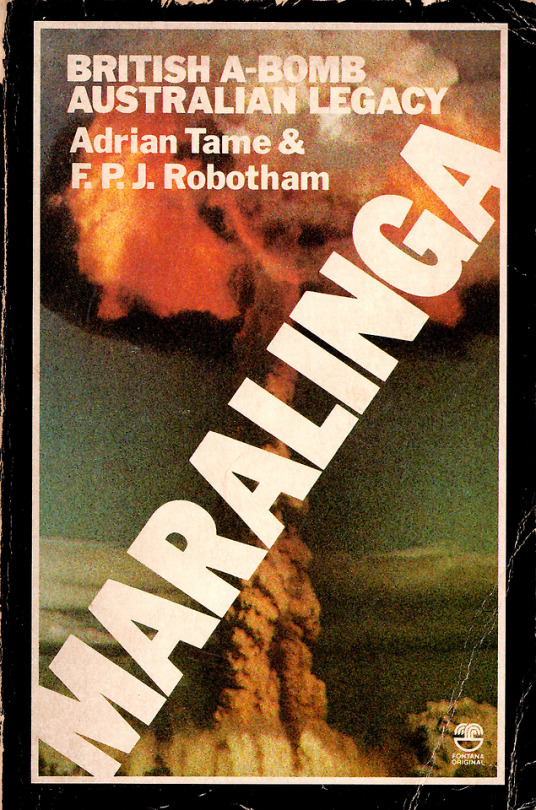
Fontana Books , 1982
#nuclear test#test site#british colony#colonialism#colonial mentality#maralinga journal: australia’s least likely tourist spot: a test site for atom bombs#maralinga
2 notes
·
View notes
Text
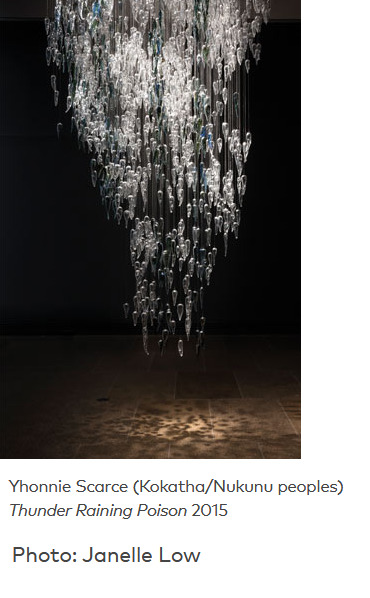
I think I’m in a position of power, I don’t usually like to use that term but compared to what my Ancestors and my grandparents had to deal with I think I’m in a really great position to talk about their history and my history. Thunder Raining Poison is a work relating to the nuclear bomb tests that happened in the 1950s at Maralinga [in ”South Australia”]. A lot of the bomb clouds had travelled across Kokatha Country, which is my grandfather’s and my Country. When I first started my research relating to Maralinga, what I found was a lot of people didn’t know about it. I found that really interesting because it wasn’t that long ago that those tests happened. I wanted to create a large-scale work that spoke about one of those bomb clouds. I felt like I needed to go up and see what was up there. I am aware that there were quite a large number of bombs tested. I felt quite uneasy at the Breakaway bombsite -- that particular bomb blast turned the surrounding dirt into glass -- so it seemed fitting that I made the cloud out of glass yams. [...] It’s a suspended work over five-metres high, so there’s over 2000 yams. I think the fact that I can make the yams out of my own breath, I find it empowering. It’s a part of who I am. It’s something I feel really strongly about. It’s something I think about every day. I’m quite proud that I am able to tell my grandfather’s story [...].
[Image, captions, and text: Yhonnie Scarce. Artist statement for Defying Empire: 3rd National Indigenous Art Triennial.]
-------
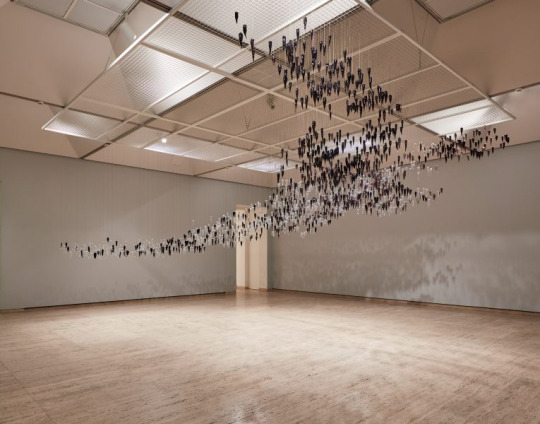
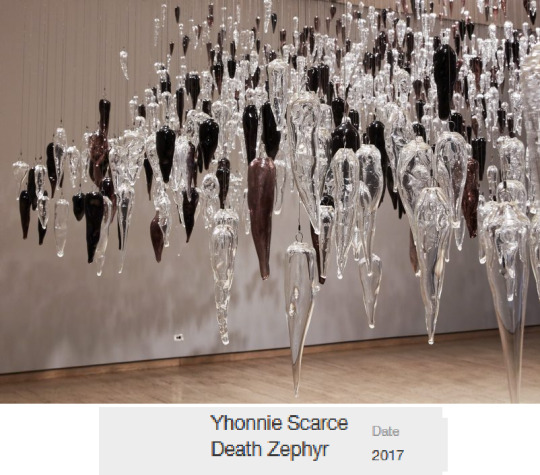
‘In the suspended, wraith-like clouds of Yhonnie Scarce’s installation ‘Death Zephyr’ 2017 we are temporarily blinded to the lingering effects of the British nuclear tests on Aboriginal land across much of inland South Australia in the 1950s. On close inspection, the beauty of the work is subsumed by a deeper sense of [...] the flagrant disregard for human life and indifference to environmental destruction [...]’ [-- Daniel Browning]. Yhonnie Scarce works predominantly in glass. Her work considers the scientific research and concepts that have impacted and have ongoing effects on Aboriginal people. In this major installation Scare employs small glass yams, which she feels represent people, to create a vast, wind-swept form that refers to the poisonous clouds that rained across Maralinga, SA [South Australia] as the British and Australian governments undertook nuclear testing there in the 1950s and 1960 forever altering the landscape and dramatically effecting people’s lives.
[Images and text: “About” section. The Art Gallery of New South Wales.]
-------
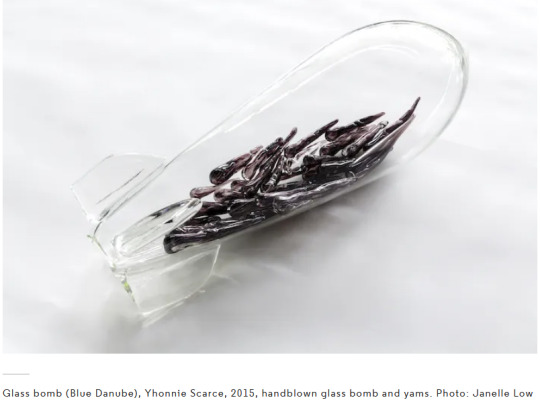
My work is related to the colonisation of Australia and the treatment of Aboriginal people, which I believe the country is yet to properly acknowledge. We often referred to the ‘amnesia’ related to this colonisation, through genocide, eugenics and blood quantum principles. [...]
Growing up as an Aboriginal woman in Australia has been tough. I have often faced questions around identity [...]. One of my works, The Cultivation of Whiteness (2013), is about scientific testing on Aboriginal people, particularly by the ethnographer Norman Tindale. In the late 1930s he travelled Australia taking skin, blood, hair and saliva samples and measuring the circumference of people’s body parts, in an attempt to classify them as fully or part Aboriginal. My artwork comprises a series of scientific beakers in which are 60 blown-glass bush bananas, coloured in black lustre with a mirror-like quality. [...] The work is also about the dissection of deceased bodies and the history of skeletal remains of Aboriginal people being sent to museums around the world. The bush bananas resemble corpses in various stages of decomposition. I often use food to refer to our culture, as well as to bodies [...].
About 15 hours west of Woomera, where my family lived, is Maralinga, where the British conducted nuclear testing in the 1950s. Dust and clouds travelled from the site across the state making many people sick, and the infant death rate was high during and after those tests. Recently I’ve made work that references these events, which I felt were not being talked about. Thunder Raining Poison (2015) is inspired by rainfall and comprises 2,000 blown glass yams suspended in a formation, 5m high and 3.5m wide. Death Zephyr (2017) represents the low-lying clouds that were the most detrimental because they were so close to where people lived.
[Image, caption, and text: Yhonnie Scarce interviewed by Debika Ray. “Glass artist Yhonnie Scarce shines a light on the oppression of Aboriginal people.” Crafts Council. 17 March 2020.]
255 notes
·
View notes
Text
Meet the man who uncovered the scandal of nuclear testing in South Australia
https://aeon.co/videos/meet-the-man-who-uncovered-the-scandal-of-nuclear-testing-in-south-australia
In the 1950s and ’60s, the British government conducted nuclear tests in Maralinga, a remote region of South Australia, with little understanding or forethought of the public health problems the fallout might cause. The harmful, sometimes deadly impact of these tests not only affected military…
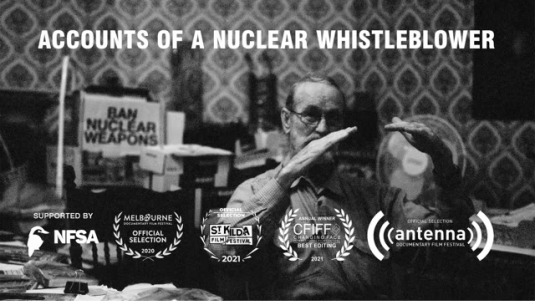
View On WordPress
1 note
·
View note
Text


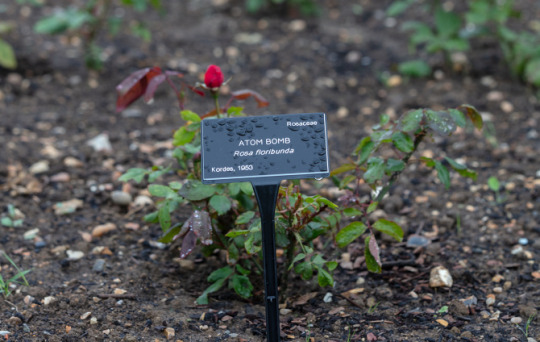

It's with disappointment that I share the news that my public installation 'An English Garden' has been taken down early, following complaints and threats made by a group of conservative local Councillors in Southend, UK. These individuals (one of whom is a former UKIP Councillor) took issue with a plaque included in the work, which critically reflected upon Britain's nuclear history and colonial legacy - that is, instead of celebrating Britain's nuclear capabilities, the work highlighted Britain's devastating nuclear tests on Indigenous Lands in Australia during the 1950s and 60s.
We were given a 48 hour ultimatum to remove the work before the Council would intervene to censor the “offending” plaque, and subject the work and associated arts communities to a national media campaign that would frame the work as “a direct far left wing attack on our History, our People and our Democratically Elected Government.” Seemingly said government and its global scale nuclear arsenal was not considered robust enough to endure the airing of historical facts and critique via a rose garden art installation.
To clarify, An English Garden consisted of a garden of Rosa floribunda “Atom Bomb” (a rare species of cold-war era rose) and “Cliffs of Dover” Iris. Additionally, brass plaques highlighting the site's proximity to the facilities where Britain assembled its early atomic weaponry in the 1950s were installed on benches. The work aimed to hold space for the contemplation of British colonial legacy - an unavoidably complicated legacy which contains such seeming opposites as rose gardens and enduring nuclear violence.
What remains of 'An English Garden' now, is a series of empty garden beds. Over the coming months, I’ll be working with others in Southend and Australia to transform this void into a space for further dialogue.
So a bunch of conservatives decided a garden commemorating the atomic tests at Maralinga was too offensive so they had it uprooted. They nuked us, or rather, they drove the Pitjantjatjara people from their land and nuked it (I've held a hunk of glass formed by the nuclear bomb melting the sand, it looked like a gobbet of phlegm), but we can't even have a rose garden because that's an "attack on the People". A bunch of Australian soldiers got leukemia after being ordered to crawl through the fallout to test whether that would cause leukemia, but what's really offensive is the plaque mentioning that it happend.
Great job. You're really protecting Britain's international reputation, you fascist bastards.
21 notes
·
View notes
Link
More than 100 kg of highly toxic uranium (U) and plutonium (Pu) was dispersed in the form of tiny 'hot' radioactive particles after the British detonated nine atomic bombs in remote areas of South Australia, including Maralinga.
Scientists say that these radioactive particles persist in soils to this day, more than 60 years after the detonations. Previously, we had limited understanding of how Pu was released from these "hot" particles into the environment for uptake by wildlife around Maralinga.
But now, a new study published today in Scientific Reports and led by Monash University researchers warns that the particles are actually more complex and varied than previously thought. This means that the processes which slowly release Pu into the environment are also much more complex and varied.
"The British detonated nine nuclear bombs and conducted hundreds of nuclear tests in outback South Australia between 1953 and 1963," said lead study author Megan Cook, a PhD student from the Monash University School of Earth, Atmosphere and Environment. "The resulting radioactive contamination and cover-up continues to haunt us."
Read more.
14 notes
·
View notes
Video
youtube
The Plains of Maralinga Alistair Hulett
“We thought we were the cleverest things going. How stupid we were. We didn't think anyone owned the land”. — Indigenous Affairs Minister Nigel Scullion in 2014
Between 1955 and 1963 the Australian government agreed to perform 7 series of atomic tests, on Aboriginal land of the Anangu people . Many Anangu people were forcibly removed from their traditional lands in the lead-up to the tests.
The forced relocation destroyed the traditional lifestyle of the Aboriginal families. "The damage was radiological, psycho-social and cultural. This change was profoundly negative and to this day, much of the work of lifting the living conditions of Aboriginal people results from the loss of traditional independence dating from the 1950s."
Survivors recall the fleeing Aboriginal people being picked up in trucks or forced on a long walk through the desert without water on routes to avoid exposure. In their memory the "momentous" event is embedded right next to creation stories.
About 1,200 Aboriginal people were exposed to radiation during the testing. The radioactive fallout, called "puyu" (black mist) by Aboriginal people, caused sore eyes, skin rashes, diarrhoea, vomiting, fever and the early death of entire families. The explosion caused blindness. Long term illnesses such as cancer and lung disease were found in the 1980s, a time when some Elders grew restless and walked back into their country. [5]
The Royal Commission into British Nuclear Test in Australia found in 1985 that attempts to ensure the safety of Aboriginal people were riddled by "ignorance, incompetence and cynicism".
The boundaries of the test fields were inadequately patrolled and the British dismissed concerns for Aboriginal people's safety with the heartless comment that "a dying race couldn't influence the defence of Western civilisation".
Source: Maralinga: How British nuclear tests changed history forever - Creative Spirits, retrieved from https://www.creativespirits.info/aboriginalculture/history/maralinga-how-british-nuclear-tests-changed-history-forever
4 notes
·
View notes